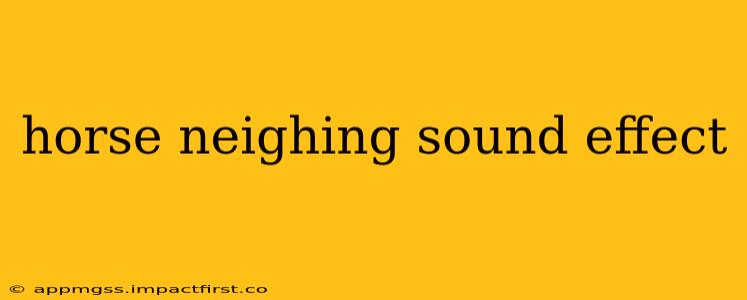The sound of a horse neighing is instantly recognizable, evoking images of vast plains, galloping steeds, and the untamed spirit of the wild. But beyond its immediate impact, the neigh holds a complex world of communication, subtle variations, and surprising scientific interest. This article delves into the fascinating world of equine vocalizations, exploring the nuances of horse neighing and answering frequently asked questions about this iconic sound.
What Does a Horse Neigh Sound Like?
A horse's neigh is a loud, high-pitched whinny, often described as a prolonged, drawn-out sound. However, it's far from monolithic. The exact sound varies depending on the horse's breed, age, health, emotional state, and the context of the vocalization. A young foal's neigh will sound much different from the deep, resonant call of a mature stallion. The intensity, pitch, and duration of the neigh all contribute to its unique character, allowing horses to convey a range of emotions and messages.
What Causes a Horse to Neigh?
Horses neigh for various reasons, primarily as a form of communication. It’s their way of connecting with other horses, especially those they know and are bonded with. Here are some common triggers:
-
Social Interaction: Neighing is a key element of social bonding. Horses use neighs to locate herd members, especially when separated. Think of it as their long-distance "hello" or "where are you?".
-
Alerting Others to Danger: A loud, frantic neigh can signal danger or distress. This acts as a warning to other horses in the vicinity.
-
Attracting Mates: Stallions often use distinctive neighs to attract mares during the breeding season, demonstrating their dominance and fitness.
-
Expressing Emotions: Neighs can also reflect a horse's emotional state. A happy, relaxed horse might produce a soft, gentle neigh, while a frightened or agitated horse may exhibit a high-pitched, anxious neigh.
How Can I Make a Horse Neighing Sound Effect?
There are several ways to create a horse neighing sound effect:
-
Using Sound Libraries: Numerous online resources and sound effect libraries offer high-quality recordings of horse neighs. Many are royalty-free, making them ideal for various applications, from films and video games to presentations and personal projects.
-
Recording Your Own: If you have access to horses, recording their neighs provides authentic sound effects, although ensuring good audio quality requires proper equipment and a quiet environment.
-
Synthesizing Sounds: Advanced audio software allows for the synthesis and manipulation of sounds, including creating realistic-sounding horse neighs, though achieving natural realism might require significant skill and experience.
What is the Difference Between a Neigh and a Whinny?
While often used interchangeably, there's a subtle distinction. A neigh is generally louder and longer, often carrying over a greater distance, while a whinny is typically shorter, softer, and more conversational. Think of the neigh as a long-distance call, and the whinny as a more intimate communication between nearby horses.
Why Do Horses Neigh at Night?
Nighttime neighing can stem from various factors: separation anxiety if a horse is alone or away from its herd, the presence of unfamiliar sounds or smells, or even just a reflection of their natural sleep cycle and communication patterns. If the neighing is excessive or persistent, it's advisable to consult with an equine veterinarian or behaviorist to rule out any underlying health or behavioral issues.
What are Other Sounds Horses Make?
Beyond neighing and whinying, horses have a surprisingly varied vocal repertoire. These include snorting, blowing, squealing, and even a soft, humming sound. Each sound holds specific meaning within the horse's communication system.
By understanding the nuances of horse vocalizations, we gain a deeper appreciation for these magnificent animals and the complex ways they interact with their world. The seemingly simple horse neigh is, in fact, a rich tapestry of sounds carrying essential information about their social lives, emotions, and well-being.
